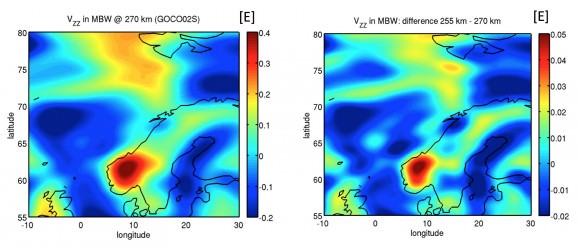Caption: GOCE over ice. Credits: ESA – AOES Medialab
Since March 2009, the European Space Agency (ESA) mission, Gravity field and steady-state Ocean Circulation Explorer (GOCE) has been orbiting Earth. It carries highly sensitive instrumentation able to detect tiny variations in the pull of gravity across the surface of the planet, allowing it to map our planet’s gravity with unrivaled precision, producing the most accurate gravity map of Earth. With the planned mission completed, the fuel consumption has been much lower than anticipated, enabling ESA to extend GOCE’s life and put it into an even lower orbit, improving the quality of the gravity model.
The GOCE spacecraft was designed to fly low and has spent most of its mission roughly 500km below most other Earth-observing missions, at an altitude of 255km. ESA’s Earth Scientific Advisory Committee recommended lowering the orbit by 20km at a rate of about 300m per day, starting in August. After coming down by 8.6 km, the satellite’s performance and orbit were assessed. Now, GOCE is again being lowered while continuing its gravity mapping. It is expected to reach 235 km by February.
Decreasing the altitude increases the spatial resolution and the precision of the data. The expected increase in data quality is so high (possibly 35%) that scientists are calling it GOCE’s ‘second mission. Volker Liebig, ESA’s Director of Earth Observation Programmes has said “What the team of ESA engineers is now doing has not been done before and it poses a challenge. But it will also trigger new research in the field of gravity based on the high-resolution data we are expecting.”
Caption: The image on the left shows GOCE’s gravity measurements over northern Europe, acquired from its previous altitude. The image on the right depicts the expected measurements over the same area after the satellite has been lowered. Credits: ESA / GOCE+ Theme 2
The first ‘geoid’ based on GOCE’s gravity measurements was unveiled in June 2010. It is a crucial reference for conducting precise measurements of ocean circulation, sea-level change and ice dynamics. The mission has also been studying air density and wind in space, and its data was recently used to produce the first global high-resolution map of the boundary between Earth’s crust and mantle, called the Mohorovicic, or “Moho” discontinuity.
As the orbit drops, atmospheric drag increasingly pulls the satellite towards Earth, so GOCE has to use the tiny thrust of its ion engine to continuously compensate for any drag to stay aloft and maintain the stability it needs to measure Earth’s gravity. GOCE has enough xenon fuel for another 50 weeks of operations. When the fuel runs out the satellite will be pulled into the deep atmosphere where it will burn up
Find out more about the GOCE mission here



The ‘Siljan Ring Structure’ shows up rather well in the gravity map depicted above. It is interesting to note how that structure relates to the actual shape of the lower peninsula. A meteorite approx. 2-3 km diameter is the suspected culprit… KABANG! Thor’s Hammer anyone?
Now you got me going! I wonder what other possible impact basins are obvious with data from this mission?